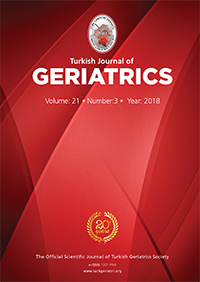2AcÄḟbadem University, Faculty of Medicine, Department of Cardiology, Adana, Turkey DOI : 10.31086/tjgeri.2018344036 Introduction: One of the most important reasons for a high mortality and morbidity rate in geriatric patients with calcific aortic stenosis is arrhythmias. Transcatheter aortic valve implantation is an alternative to conventional aortic valve surgery for high-risk patients because of its less-invasive nature. Although hemodynamic and functional recoveries are established after transcatheter aortic valve implantation, whether it leads to a decrease in the risk of atrial fibrillation, ventricular arrhythmia and sudden cardiac death remains unclear. Thus, this study aimed to evaluate the risks associated with aortic stenosis by assessing the rates of P wave dispersion for estimating the atrial fibrillation risk and QT interval dispersion, Tp-e interval, and Tp-e/QT ratio for ventricular arrhythmia and assessing sudden cardiac death risk before and after implantation.
Materials and Method: In a retrospective study, a total of 39 subjects [14 males (35.89%) and 25 females (64.11%); mean age=81.51Âḟ8.79 years] were enrolled. P wave/QT interval dispersion, Tp-e interval and Tp-e/QT ratio values before and 3rd months after implantation were calculated and compared.
Results: There was a statistically significant decline in P wave/QT interval dispersion, Tp-e interval, Tp-e/QT ratio values between preoperative, and 3rd, months (43.72Âḟ7.78 vs. 35.15Âḟ8.92, 61.64Âḟ17.36 vs. 49.41Âḟ12.64, 84.59Âḟ7.64 vs. 73.21Âḟ6.46, 0.21Âḟ0.01 vs. 0.18Âḟ0.01, respectively, p<0.001 for all comparisons).
Conclusion: P wave/QT interval dispersion, Tp-e interval and Tp-e/QT ratio were shown to be attenuated after transcatheter aortic valve implantation. These results indirectly offer that there may be a reduction in risk of atrial fibrillation, ventricular arrhythmias and sudden cardiac death.
Keywords : Aortic Valve Stenosis; Atrial fibrillation; Death, Sudden, Cardiac; Transcatheter Aortic Valve Replacement
